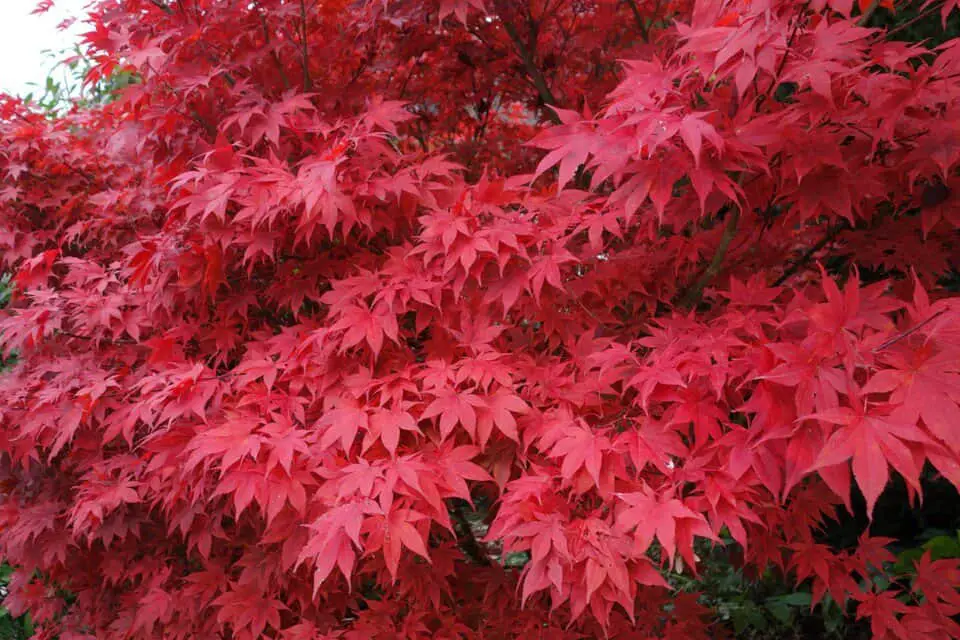Some links in the post are affiliate links and I get a commission from purchases made through some links found in the post.
Raising a healthy red maple tree is relatively easy. The plant is not highly demanding. It can even tolerate clay soils without suffering root rot and dying.
Not many trees are that adaptable, which makes it a good choice even for a budding beginner who has never dealt with verticillium wilt.
However, it’s easy to make some common mistakes with this tree, which can rob you of the chance to enjoy its beautiful varying foliage. Sometimes, you may provide your tree with too much light or too little light.
So, how much light does your red maple tree need? Ideally, it should be in full to partial sun getting at least 6 hours of light a day.
Younger red maple trees can be grown in artificial lights if you meet the necessary requirements.
I will explain why this is the case, how you can achieve such light, and how to vary its lighting needs based on your climate. Let’s get into it:
What Type of Light Does My Red Maple Need?
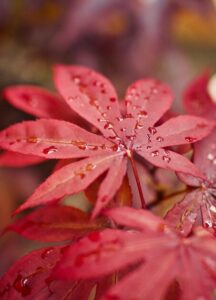 The red maple does best in partial or full sun. Full sun (bright and direct light) refers to light exposure for at least six hours a day between 10 in the morning and 4 in the evening.
The red maple does best in partial or full sun. Full sun (bright and direct light) refers to light exposure for at least six hours a day between 10 in the morning and 4 in the evening.
Exposure outside this range still counts as long as the plant gets six hours a day. Partial sun (bright and indirect light) refers to 4 to 6 hours of light exposure each day.
I will detail why the plant needs this kind of light and how you can achieve this in later sections.
How Much Light Does a Red Maple Need?
The red maple is a flowering tree that blooms in the spring, producing small and red beautiful flowers. And like any flowering species, there is some science behind the blooming.
It all starts with converting light, water, and nutrients into food for the plant through a process known as photosynthesis.
Thus, even if the tree has access to enough water and a good NPK formula, it cannot produce enough food without light.
Instead, it would make just enough food to support foliage development. And in the spring, you would not enjoy any flowers.
But how much light does your tree need? – At least six hours a day. This exposure should continue through spring down to the fall to ensure you can witness the changes in the tree.
In the spring, it should produce healthy green leaves, contrasting its red flowers. And in the fall, its leaves should take on a red, yellow, or orange hue.
Finally, the tree should lose its leaves at the end of fall, paving the way for red stems in the winter to give you a fitting end to the year.
None of these processes can be optimal if the tree does not have access to light, which is essential to making the food (energy) to support these activities.
Let’s relate this light requirement to the USDA growing zones. You can grow a red maple in zones 3 to 9. The lower zones are much cooler, and the sun’s rays are not too harsh.
In such cases, you can expose the red maple to full sun for at least six hours a day. But in the higher zones, full sun exposure could be too much for your red maple – in that case, you can leave the tree in partial sun for at least six hours a day.
You may also like: What fertilizer should you use for your red maple
What Happens If Your Red Maple Gets Too Little Light?
The red maple should receive at least six hours of partial to full sun each day during its active growing period. So, what happens when you do not meet this quota?
1) The Red Maple Does Not Bloom Well
Without adequate access to light, your tree cannot photosynthesize enough to produce enough food for foliage development and flowering.
So, it focuses on using the available energy to produce more leaves. As such, your plant may seem healthy and may have green leaves but come spring, you will not see any flowers.
2) The Tree Shows Sparse Growth
If your tree does not get enough light, it does not produce as many leaves as it usually would. Thus, the branches feature fewer leaves which are far from each other.
You can tell that this is the case by comparing the internodal distance between newer and older growth.
3) The Tree Leans Towards the Light
Your tree will always lean into the most optimal conditions. If you leave it in the shade, it will start growing towards the place with more light.
You will notice that its stem and branches have leaned towards the site with the source of light. As a result, one side of the tree may have fuller and healthier leaves while the other may have sparse growth.
4) The Red Maple may Have Small Leaves
A reduction in leaf size can sometimes signal a reduced nitrogen percentage in the soil. But if your tree has adequate access to nutrients and water, light could be the issue.
The plant needs all these essentials to make food. And when you remove the light from the equation, it cannot produce enough food to develop healthy leaves. It thus uses the energy available to create small leaves.
5) The Tree Suffers Stunted Growth
Is your red maple growing at an agonizing rate? Lack of light could be the issue. While it’s normal for your tree to experience a dip in its growth rate in the winter, it should perk up in the spring.
But if this is not happening yet, it has access to water and nutrients, you might want to pay more attention to how much light it gets.
6) The Tree’s Leaves have Browned
Often, people equate browning leaves to sun damage. But it can also result from low light exposure.
If you notice such a change, investigate other reasons that could lead to the browning. If none of them checks out, assess just how much light your plant gets.
7) The Soil Remains Moist for Weeks
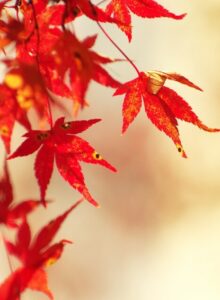 The red maple likes slightly moist soil and can even do well in dry soil. As it makes food, it uses the moisture in the soil, and you find that you need to water it about once a week.
The red maple likes slightly moist soil and can even do well in dry soil. As it makes food, it uses the moisture in the soil, and you find that you need to water it about once a week.
If you’ve noticed that the soil remains wet for days on end, the tree might have poor light exposure. As such, it cannot make food and does not make much use of the water. You should act fast, in this case, to avoid triggering root rot.
These issues are common in red maples positioned in partial or full shade. They can also present in lower USDA zones where partial sun may not be enough to sustain the tree’s growth.
You may also like: What are the common red maple problems & how to fix them
What Happens If Your Red Maple Gets Too Much Light?
While the red maple enjoys full sun, the light exposure can be too much in the higher USDA zones, where the corresponding temperatures are often just as high. Is this the case with your red maple? Below are the warning signs:
1) The Leaves on the Tree Start Drooping
If the plant has access to too much sun, the rate of evaporation and transpiration may exceed that of water absorption.
It results in dehydration, forcing the leaves to droop to reduce the surface area available to the sun. If this exposure continues for a long time, the leaves can start dying and falling off the tree.
2) The Tree may Develop Brown Patches on its Leaves
Browning can indicate a lack of adequate light. But when it exhibits as patches on the leaves, this could also be a sign of sunburn.
It occurs when the leaves are dehydrated and exposed to hot sun rays. The leaves dry out, and the rays damage their cells. Such changes are irreversible and hamper the plant’s ability to make food.
3) The Leaves on the Tree may Appear Pale
Leaf damage due to too much sun exposure can also exhibit as paling/ discoloration of the leaves.
4) The Leaves can Turn Crispy
When leaves don’t have enough access to water and are losing a lot to the environment, they can dry and feel crisp. Such changes are also irreversible and damaging to the tree’s health.
5) The Soil may feel Crumbly
When your tree has access to poor lighting, it does not use up the water in the soil, which results in the soil being moist for prolonged periods.
But when it has too much exposure to the sun, it dries out and becomes crumbly. This change interferes with the tree’s ability to absorb nutrients and water from the soil.
Your tree may also feel too hot to the touch, indicating unfavourable temperatures. If your tree shows such signs, you can add a shade around it or move it to another location.
You may also like: 6 reasons your acer tree is dying & how to fix it
Can Red Maples Grow in Shade?
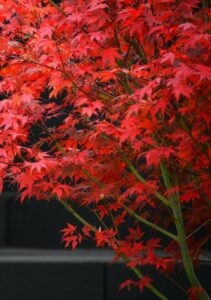 Shade falls into two categories. The first is partial shade which relates to 4 to 6 hours of light exposure. The other is full shade which implies up to 4 hours of light exposure.
Shade falls into two categories. The first is partial shade which relates to 4 to 6 hours of light exposure. The other is full shade which implies up to 4 hours of light exposure.
The red maple is best described as being tolerant to shade. Its seedlings can do well in both types of shade. However, mature trees are less tolerant of this reduced light exposure.
They can do well in partial shade, but the blooms would be pretty disappointing, more so in the cooler climates. And in the full shade, they would develop smaller leaves and not bloom. It’s best to avoid shading them at all.
Can Red Maples Be in Full Sun?
Red maples are light-loving plants that do best when they receive at least 6 hours of full to partial sun each day. Thus, placing them in the full sun would encourage healthy development.
Please note that positioning the red maples in partial sun might be the better option in higher USDA zones.
Where To Place Your Red Maple to Get the Best Light
Red maples grow in the full or partial sun and do not do well in partial or full shade. You can place them in the below positions to help them access as much light as crucial to their development and blooming:
1) For Full Sun
If you live in the lower USDA zones, it is best to place your red maple in the full sun to give it the best chance of thriving. Position the tree towards the south of the garden if you live in the northern hemisphere.
And if you live in the south, locate the tree towards the south of your garden. These spots receive bright and direct light for more than 6 hours a day.
2) For Partial Sun
Suppose you live in the higher USDA zones and have concerns about the temperature ranges in the summer. In that case, you should locate the plant towards the east of the garden.
It will receive direct morning rays, which are gentle but effective in photosynthesis. Placing your red maple in the west of the garden would subject it to the afternoon rays, which can be harsh in the hotter regions.
But if you live in the lower zones, you can place your tree towards the west.
If your red maple is indoors, you can place it towards a south, east, west, or north window, depending on your hemisphere and USDA growing zone.
When you move it outside, be picky about where you plant it. Else, you may need to transplant it after a few years to move it to a more suitable location.
You may also like: Japanese maple vs red maple
Can Red Maples Grow in Artificial Light?
Younger red maples in pots may be grown indoors until they are mature enough for the outdoors. You can also grow red maples indoors for longer periods if you can curb their growth at two feet.
When growing the trees indoors, you may realize that the conditions are not ideal for their development. The good news is that you can always supplement natural light with some artificial lights.
How To Grow a Red Maple Using an Artificial Light
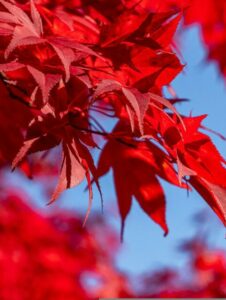 You can choose between many types of light when finding the right fit to replicate what the tree would get from the sun.
You can choose between many types of light when finding the right fit to replicate what the tree would get from the sun.
Ensure that the light has red and blue light wavelengths, which are crucial to foliage and flower development. You should hang the light above the tree and observe the following distances between the tree top and the light:
- HID Lights: At least 12 inches,
- LED Lights: At least 16 inches, and
- Fluorescent Lights: At most 12 inches.
These distances help you control how much heat reaches the tree and enable you to prevent bleaching the tree’s leaves or burning them. Please note that the higher the wattage in non-LED lights, the bigger the distance you will need to observe.
You may also like: Why is Your red maple turning green & how to fix it
Final Thoughts
Once you align your red maple’s light requirements with your USDA zone, you will have an easier time deciding where to position the plant. If in doubt, place it in full sun, then amend its position as needed.
Happy Gardening!

